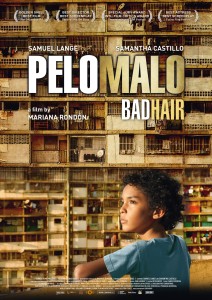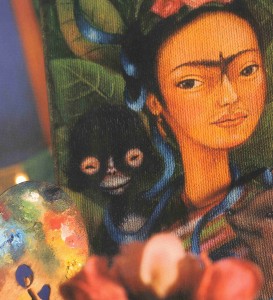 It’s no secret that we’re huge fans of Benjamin Alire Sáenz at Vamos a Leer. We love his poetry, adult fiction, young adult novels, and children’s literature. As we continue to highlight resources and literature that present nuanced interpretations of Latinx identity, this week’s En la Clase is all about Sáenz’s bilingual children’s book A Perfect Season for Dreaming/Un Tiempo Perfecto Para Soñar.
It’s no secret that we’re huge fans of Benjamin Alire Sáenz at Vamos a Leer. We love his poetry, adult fiction, young adult novels, and children’s literature. As we continue to highlight resources and literature that present nuanced interpretations of Latinx identity, this week’s En la Clase is all about Sáenz’s bilingual children’s book A Perfect Season for Dreaming/Un Tiempo Perfecto Para Soñar.
Cinco Puntos Press offers the following description of the book: “An old man tells his granddaughter about the nine most beautiful dreams of his lifetime. So, what exactly is the perfect season for dreaming? For Octavio Rivera, it’s summer, when the sky is so blue and a few lovely clouds come floating along to decorate it. It turns out that Octavio Rivera is a beautiful dreamer. And on these first long days of summer, he is visited by some very interesting dreams. But Octavio doesn’t tell anyone about his dreams, not after the first one, not after the second, not after the next or the next or the next. Finally, though, he can’t stand it anymore and he wants to tell someone so bad that his heart hurts. He decides that the only one he can trust with his dreams, the only one who won’t make fun of him for being too old or eating too much chorizo, the only one who will understand is his young granddaughter Regina because she also has beautiful and fantastic dreams. And that sets Octavio Rivera free to enjoy one last long and lovely dream.”
At a glance, it may seem like a simple counting book, but it’s so much more, making it appropriate even for children who are long past learning their numbers. This is a book that is not only beautifully written and illustrated, but provides authentic, engaging, culturally relevant content as well.
Culturally relevant pedagogy (also referred to as culturally responsive teaching or multicultural education) has quickly become one of  the new buzz terms in education over the past decade. Many cite Gloria Ladson Billings as the scholar who brought the concept to the forefront of educational conversation and research. For Ladson Billings, one of the key pieces to culturally relevant pedagogy is that it “empowers students intellectually, socially, emotionally and politically by using cultural referents to impart knowledge, skills, and attitudes” (The Dreamkeepers). Woven throughout Octavio Rivera’s dreams are cultural referents that will speak to many Latinx, Mexican, Mexican-American, Chicano, and Hispanic children. Many will recognize the Spanish guitars, blooming desert cacti, armadillos, and marachi singers as familiar cultural references. Children from the Southwest will delight in seeing some of their own hometowns mentioned in the story, as Denver, El Paso, Júarez, Lubbock, and Tucson all make appearances in the text. Esau Andrade Valencia’s illustrations bring the surrealistic dreams to life, offering authentic colorful desert landscapes. For students who aren’t familiar with any of this, the reading allows them to experience and learn about something new in a way that doesn’t perpetuate damaging cultural stereotypes.
the new buzz terms in education over the past decade. Many cite Gloria Ladson Billings as the scholar who brought the concept to the forefront of educational conversation and research. For Ladson Billings, one of the key pieces to culturally relevant pedagogy is that it “empowers students intellectually, socially, emotionally and politically by using cultural referents to impart knowledge, skills, and attitudes” (The Dreamkeepers). Woven throughout Octavio Rivera’s dreams are cultural referents that will speak to many Latinx, Mexican, Mexican-American, Chicano, and Hispanic children. Many will recognize the Spanish guitars, blooming desert cacti, armadillos, and marachi singers as familiar cultural references. Children from the Southwest will delight in seeing some of their own hometowns mentioned in the story, as Denver, El Paso, Júarez, Lubbock, and Tucson all make appearances in the text. Esau Andrade Valencia’s illustrations bring the surrealistic dreams to life, offering authentic colorful desert landscapes. For students who aren’t familiar with any of this, the reading allows them to experience and learn about something new in a way that doesn’t perpetuate damaging cultural stereotypes.
Discussion Suggestions:
While young readers will certainly appreciate the structure and rhythm of the counting book, the simple text provides the opportunity to discuss so much more. One of the more special elements of the story is Octavio’s relationship with his six-year-old granddaughter. She is the only one he trusts to share his dreams with. Their relationship provides the opportunity to introduce students to issues of ageism and breakdown many of the labels and stereotypes applied to the very old or the very young. Ask students to think about the kinds of stereotypes we have about people who are older or younger. What words or pictures do they associate with those who are very old or very young? Then, ask them if they have a friend who is much older or younger. Does this person fit these stereotypes? What is their relationship like with that person? Ask them to think about why Octavio only chooses to share his dreams with his granddaughter. Have them imagine that they have an older friend like Octavio. What kinds of things could they share with that friend that they might not be able to share with someone their own age? Discuss these ideas as a class.

Activity Suggestions:
When asked about the book, Sáenz wrote, “As a boy, I always hoped that when we broke the piñata at a party, that all sorts of beautiful things would come flying out. Nothing ever came out but candy. I suppose I wrote this book to set the world right.” The fantastical, surreal, and magical nature of the book makes it perfect for the beginning of the year. Often times the first month or two of the school year is focused on the teaching and establishing of routines, procedures, and expectations. While necessary, all of this does little to encourage or build creativity. A book like this offers a counterbalance. It offers a celebration of the power of dreaming, something we don’t often talk about in our classrooms. It’s also a chance for students to tap into their imaginations and practice a little inspired inventiveness. Use the book’s text and imagery as a model. Copying the dreaming premise of the book, ask students to create a counting book using their own cultural referents blended together with other fantastical elements. If time is short, assign each student one number and have them create a page just for that number. Then, combine each student’s page to create a class counting book. If possible, have them visit a younger class and read their book to that class.
We’re not alone in thinking this is a wonderful book. It has received a number of awards and honors, including the Kids’ Indie Next List (Winter 2008-09); Tejas Star Book Award; Paterson Prize; Best Book for Children; Texas Institute of Letters (TIL); Bank Street’s Best Children’s Books of the Year (2009); and Américas Book Award Honor Book (2009).
As always, if you’ve used the book with your students, we’d love to hear about it. If your students make their own counting books, we’d love to see their creations! Just post a picture in the comments below. Children’s art and writing is one of my most favorite things to see!
Until next week,
Katrina
Save
Save
Save
Save
Save
Save
Save
Save
Save
Save











 As more and more people begin to talk about the need for diversity in our classroom curricula and literature, we must remember that diversity can’t exist just for diversity’s sake. Conversations in our classrooms around diversity can intentionally or unintentionally lead to the perpetuation of stereotypes and labels. As Colleen pointed out in
As more and more people begin to talk about the need for diversity in our classroom curricula and literature, we must remember that diversity can’t exist just for diversity’s sake. Conversations in our classrooms around diversity can intentionally or unintentionally lead to the perpetuation of stereotypes and labels. As Colleen pointed out in 






